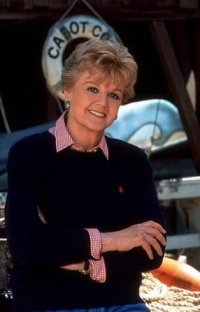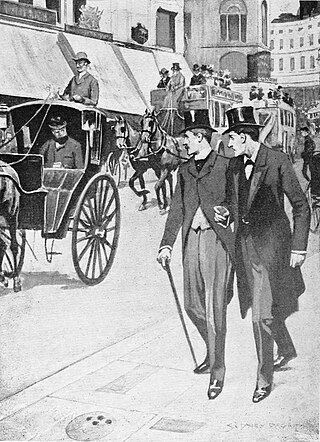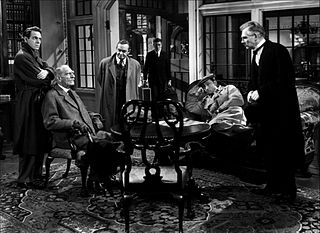Related Research Articles

Dame Agatha Mary Clarissa Christie, Lady Mallowan, was an English writer known for her 66 detective novels and 14 short story collections, particularly those revolving around fictional detectives Hercule Poirot and Miss Marple. She also wrote the world's longest-running play, the murder mystery The Mousetrap, which has been performed in the West End of London since 1952. A writer during the "Golden Age of Detective Fiction", Christie has been called the "Queen of Crime"—a moniker which is now trademarked by her estate—or the "Queen of Mystery". She also wrote six novels under the pseudonym Mary Westmacott. In 1971, she was made a Dame (DBE) by Queen Elizabeth II for her contributions to literature. Guinness World Records lists Christie as the best-selling fiction writer of all time, her novels having sold more than two billion copies.
Miss Jane Marple is a fictional character in Agatha Christie's crime novels and short stories. Miss Marple lives in the village of St. Mary Mead and acts as an amateur consulting detective. Often characterized as an elderly spinster, she is one of Christie's best-known characters and has been portrayed numerous times on screen. Her first appearance was in a short story published in The Royal Magazine in December 1927, "The Tuesday Night Club", which later became the first chapter of The Thirteen Problems (1932). Her first appearance in a full-length novel was in The Murder at the Vicarage in 1930, and her last appearance was in Sleeping Murder in 1976.

Detective fiction is a subgenre of crime fiction and mystery fiction in which an investigator or a detective—whether professional, amateur or retired—investigates a crime, often murder. The detective genre began around the same time as speculative fiction and other genre fiction in the mid-nineteenth century and has remained extremely popular, particularly in novels. Some of the most famous heroes of detective fiction include C. Auguste Dupin, Sherlock Holmes, and Hercule Poirot. Juvenile stories featuring The Hardy Boys, Nancy Drew, and The Boxcar Children have also remained in print for several decades.

A whodunit is a complex plot-driven variety of detective fiction in which the puzzle regarding who committed the crime is the main focus. The reader or viewer is provided with the clues to the case, from which the identity of the perpetrator may be deduced before the story provides the revelation itself at its climax. The investigation is usually conducted by an eccentric, amateur, or semi-professional detective.

Crime fiction, detective story, murder mystery, mystery novel, and police novel are terms used to describe narratives that centre on criminal acts and especially on the investigation, either by an amateur or a professional detective, of a crime, often a murder. It is usually distinguished from mainstream fiction and other genres such as historical fiction or science fiction, but the boundaries are indistinct. Crime fiction has several subgenres, including detective fiction, courtroom drama, hard-boiled fiction, and legal thrillers. Most crime drama focuses on crime investigation and does not feature the courtroom. Suspense and mystery are key elements that are nearly ubiquitous to the genre.

Murder on the Orient Express is a work of detective fiction by English writer Agatha Christie featuring the Belgian detective Hercule Poirot. It was first published in the United Kingdom by the Collins Crime Club on 1 January 1934. In the United States, it was published on 28 February 1934, under the title of Murder in the Calais Coach, by Dodd, Mead and Company. The UK edition retailed at seven shillings and sixpence (7/6) and the US edition at $2.

Mystery is a fiction genre where the nature of an event, usually a murder or other crime, remains mysterious until the end of the story. Often within a closed circle of suspects, each suspect is usually provided with a credible motive and a reasonable opportunity for committing the crime. The central character is often a detective, who eventually solves the mystery by logical deduction from facts presented to the reader. Some mystery books are non-fiction. Mystery fiction can be detective stories in which the emphasis is on the puzzle or suspense element and its logical solution such as a whodunit. Mystery fiction can be contrasted with hardboiled detective stories, which focus on action and gritty realism.

Crime fiction is a typically 19th-, 20th- and 21st-century genre, dominated by British and American writers. This article explores its historical development as a genre.

Jessica Beatrice "J. B." Fletcher is a fictional detective and writer and the main character and protagonist of the American television series Murder, She Wrote. Portrayed by award-winning actress Angela Lansbury, Fletcher is a best-selling author of mystery novels, an English teacher, amateur detective, criminology professor, and congresswoman. In 2004, Fletcher was listed in Bravo's "100 Greatest TV Characters". AOL named her one of the "100 Most Memorable Female TV Characters". The same website listed her among "TV's Smartest Detectives". She was ranked at number six on Sleuth Channel's poll of "America's Top Sleuths". Guinness World Records called her the "most prolific amateur sleuth".

The Murder at the Vicarage is a work of detective fiction by British writer Agatha Christie, first published in the UK by the Collins Crime Club in October 1930 and in the US by Dodd, Mead and Company later in the same year. The UK edition retailed at seven shillings and sixpence and the US edition at $2.00.

Miss Marple, titled Agatha Christie's Miss Marple in the series, is a British television series based on the Miss Marple murder mystery novels by Agatha Christie, starring Joan Hickson in the title role. It aired from 26 December 1984 to 27 December 1992 on BBC1. All twelve original Miss Marple novels by Christie were dramatised.

A Mysterious Affair of Style is a whodunit mystery novel by British writer Gilbert Adair, first published in 2007. A homage to the Golden Age of Detective Fiction in general and Agatha Christie in particular, the novel is a sequel to Adair's 2006 book, The Act of Roger Murgatroyd.

The gentleman detective, less commonly lady detective, is a type of fictional character. He has long been a staple of crime fiction, particularly in detective novels and short stories set in the United Kingdom in the Golden Age. The heroes of these adventures are typically both gentlemen by conduct and often also members of the British gentry. The literary heroes being in opposition to professional police force detectives from the working classes.
Over My Dead Body is a comedy/thriller play, written by Michael Sutton and Anthony Fingleton, "suggested by" Robert L. Fish's 1968 novel The Murder League.

A Beautiful Blue Death, by Charles Finch, is the first novel in a series of mysteries featuring Victorian gentleman and amateur detective Charles Lenox.

The closed circle of suspects is a common element of detective fiction, and the subgenre that employs it can be referred to as the closed circle mystery. Less precisely, this subgenre – works with the closed circle literary device – is simply known as the "classic", "traditional" or "cozy" detective fiction.
Sarah Keate is a fictional character, the protagonist in a series of medical mystery novels by American author Mignon G. Eberhart.
Sylvia Haymon was a British writer of mystery fiction, autobiography, and other fiction and nonfiction. As an adult, she worked in public relations, broadcasting, journalism, and farming, and published nonfiction that included two childhood memoirs, a historical novel, biographies of Bonnie Prince Charlie and Monmouth, and a history of Norwich, her birthplace. Writing under the pseudonym S. T. Haymon, she became well-known for her police procedural series featuring Detective Inspector Ben Jurnet. She won the Crime Writers Association Silver Dagger Award in 1983 for Ritual Murder.
References
- ↑ What Makes a Cozy Mystery?|Novel Suspects
- ↑ 25 Of The Absolute Best Cozy Mystery Series|Book Riot
- 1 2 3 What Makes a Cozy Just That?|Cozy Mystery List
- ↑ Stasio, Marilyn (October 18, 1992). "CRIME/MYSTERY; Murder Least Foul: The Cozy, Soft-Boiled Mystery". The New York Times.
- ↑ Christian, Citron (11 April 2014). "Was Angela Lansbury Serial Killer on Murder She Wrote? | TheBlot". TheBlot Magazine. Retrieved 14 October 2019.
- ↑ Theme page on cozy mystery blog
- ↑ Novel Investigation: A Brief History of Cozy Mysteries|Novel Suspects
- 1 2 3 4 "Rita Mae Brown". Cozy-Mystery.com.
- ↑ 25 Of The Absolute Best Cozy Mystery Series|Book Riot
- ↑ Coronavirus: Murder, but gentler: 'Cozy' mysteries a pandemic-era balm|CTV News
- ↑ Snyder, Diane (2 February 2022). "'Sister Boniface': Crime-Solving Nun Gets the Spotlight in 'Father Brown' Spinoff". TV Insider.
- ↑ Saunders, Tristram Fane (21 June 2023). "Thank heavens Bill Nighy isn't too grand to grace our airwaves". The Telegraph.